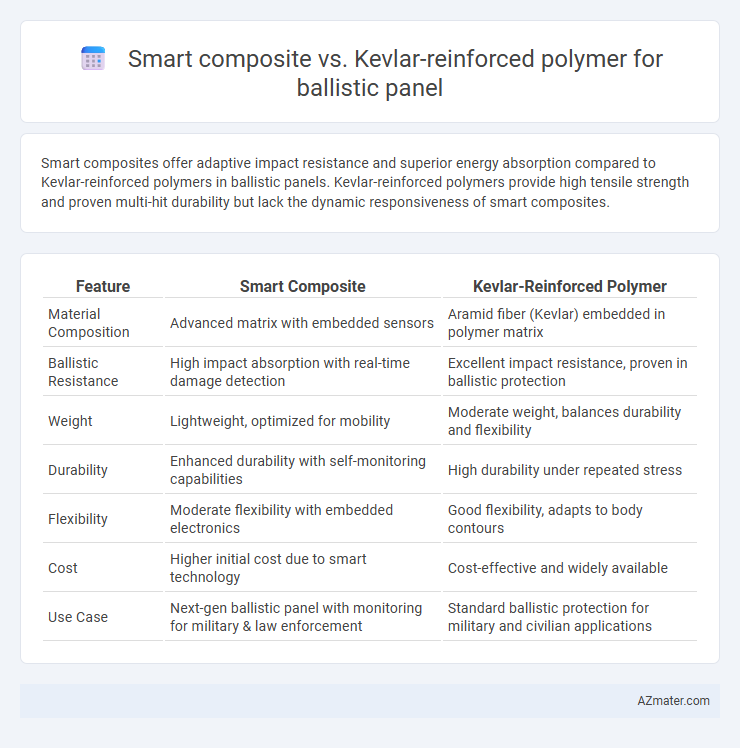Smart composites offer adaptive impact resistance and superior energy absorption compared to Kevlar-reinforced polymers in ballistic panels. Kevlar-reinforced polymers provide high tensile strength and proven multi-hit durability but lack the dynamic responsiveness of smart composites.
Table of Comparison
| Feature | Smart Composite | Kevlar-Reinforced Polymer |
|---|---|---|
| Material Composition | Advanced matrix with embedded sensors | Aramid fiber (Kevlar) embedded in polymer matrix |
| Ballistic Resistance | High impact absorption with real-time damage detection | Excellent impact resistance, proven in ballistic protection |
| Weight | Lightweight, optimized for mobility | Moderate weight, balances durability and flexibility |
| Durability | Enhanced durability with self-monitoring capabilities | High durability under repeated stress |
| Flexibility | Moderate flexibility with embedded electronics | Good flexibility, adapts to body contours |
| Cost | Higher initial cost due to smart technology | Cost-effective and widely available |
| Use Case | Next-gen ballistic panel with monitoring for military & law enforcement | Standard ballistic protection for military and civilian applications |
Introduction to Ballistic Panels
Ballistic panels are critical components in personal and vehicular armor systems, designed to absorb and dissipate the energy from high-velocity projectiles. Smart composites integrate advanced materials with embedded sensors to enhance real-time threat detection and adaptive response, offering superior protection and functionality. Kevlar-reinforced polymers, known for their high tensile strength and lightweight properties, provide reliable impact resistance and have been the industry standard for ballistic protection for decades.
Understanding Smart Composite Materials
Smart composite materials in ballistic panels incorporate adaptive fibers and embedded sensors to enhance impact resistance and damage detection, outperforming traditional Kevlar-reinforced polymers that primarily rely on high tensile strength fibers. These composites utilize responsive matrices that alter mechanical properties in real time, enabling improved energy absorption and structural integrity under ballistic impact. Understanding the integration of nanoscale reinforcements and smart polymers is critical for advancing next-generation ballistic armor with superior durability and multifunctionality.
Overview of Kevlar-Reinforced Polymers
Kevlar-reinforced polymers are widely recognized for their exceptional tensile strength and lightweight properties, making them a preferred choice for ballistic panels. These composites combine Kevlar fibers with polymer matrices to enhance impact resistance and energy absorption, effectively dissipating ballistic threats. Their high durability and flexibility contribute to improved protection without compromising mobility in personal armor applications.
Comparative Material Properties
Smart composites offer enhanced adaptability and self-healing properties, improving durability and impact resistance compared to Kevlar-reinforced polymers. Kevlar-reinforced polymers provide exceptional tensile strength and lightweight ballistic protection, widely used in body armor and ballistic panels. The choice between smart composites and Kevlar-based materials depends on specific performance requirements such as flexibility, weight, and multi-hit resistance in ballistic applications.
Ballistic Performance Analysis
Smart composite ballistic panels exhibit superior energy absorption and impact resistance compared to Kevlar-reinforced polymers, achieving higher V50 ballistic limits under standardized testing protocols. The integration of advanced nano-materials within smart composites enhances fracture toughness and delay crack propagation, resulting in improved multi-hit capability and reduced deformation. Kevlar-reinforced polymers maintain high tensile strength and weight efficiency, but their ballistic performance can degrade faster under repeated impact, limiting long-term protective effectiveness.
Weight and Flexibility Considerations
Smart composite ballistic panels offer significantly reduced weight compared to Kevlar-reinforced polymers, enhancing wearer mobility and comfort during extended use. The advanced matrix materials in smart composites provide superior flexibility without compromising structural integrity, allowing for better contouring to body shapes. Kevlar-reinforced polymers, while strong and impact-resistant, tend to be bulkier and less adaptable, often limiting ease of movement in tactical scenarios.
Durability and Environmental Resistance
Smart composite ballistic panels demonstrate superior durability through enhanced impact energy absorption and improved resistance to microcracking compared to Kevlar-reinforced polymers, which may suffer from fiber delamination under repeated stress. Environmental resistance in smart composites is optimized via nanomaterial integration, providing exceptional tolerance to moisture, UV radiation, and temperature fluctuations, whereas Kevlar-reinforced polymers tend to degrade and lose mechanical properties when exposed to prolonged humidity and UV exposure. These factors position smart composite panels as a more reliable solution in harsh environments requiring long-term ballistic protection.
Cost-Effectiveness and Scalability
Smart composite ballistic panels offer superior cost-effectiveness through reduced raw material expenses and streamlined manufacturing processes compared to Kevlar-reinforced polymers. The scalability of smart composites benefits from adaptable fabrication techniques like automated layering and 3D printing, enabling rapid production increases without significant cost hikes. Kevlar-reinforced polymers, while proven for high-impact resistance, often face limitations in mass production due to higher material costs and complex weaving methods.
Applications in Personal and Vehicle Armor
Smart composites integrating sensors and adaptive materials enhance ballistic panels by providing real-time impact detection and energy dissipation, improving personal and vehicle armor responsiveness. Kevlar-reinforced polymers remain a gold standard for lightweight, high-strength ballistic protection, widely used in military helmets, vests, and armored vehicle panels due to their proven durability and resistance against high-velocity projectiles. Combining smart composites with Kevlar layers optimizes threat detection and physical protection, advancing the effectiveness of personal protective equipment and vehicle armor systems.
Future Trends in Ballistic Panel Technology
Smart composites integrating advanced sensors and adaptive materials offer real-time threat detection and dynamic response capabilities, surpassing traditional Kevlar-reinforced polymers in ballistic panel technology. Future trends emphasize lightweight, multifunctional panels combining high-impact resistance with embedded smart functionalities such as health monitoring and self-healing properties. Research is driving the development of hybrid systems that merge Kevlar's proven tensile strength with smart composite adaptability to enhance protection and operational efficiency in military and law enforcement applications.

Infographic: Smart composite vs Kevlar-reinforced polymer for Ballistic panel
 azmater.com
azmater.com